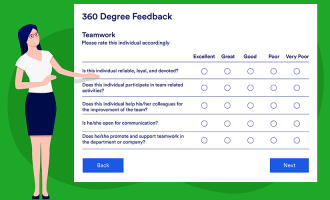Let’s get the obvious out of the way. Performance appraisals are universally difficult to get right. They’re a struggle for just about every business, and they come with so many moving parts that there isn’t a simple prescription for success.
If you dive into HR literature, you’ll find conflicting ideas about what makes a good performance review, seemingly constant debates about which methods actually work the best, and frequent shifts in trends. It’s up to you to look past the hype around any given performance appraisal method and identify why it’s getting so much attention and if the concept is a good fit for your business.
Pro Tip
Do you need to evaluate the performances of your employees? Start using Jotform’s beautiful performance review form templates for free.

With all of that in mind, we’ve created this guide to give you an overview of the ideas and practices commonly used in performance appraisals. This baseline knowledge will hopefully give you the foundational information you need to analyze performance management in your business and turn to more specialized resources for specific issues you want to take a deep dive into.
This guide contains five chapters:
- Introduction
- What is a performance appraisal?
- The importance of performance appraisals. Do these things even matter? The answer is a resounding yes. Learn why, plus get tips on how to create an effective framework to get them done.
- The performance appraisal process. Processes will differ from business to business, but there are some common, critical elements that they all share.
- 8 performance appraisal methods. Analyze your staff, create a cohesive plan for the kind of culture you want to create, and identify what your employees want from performance appraisals.
- Performance appraisal software.
What is a performance appraisal?
Simply put, it’s the process of assessing employee performance to both evaluate the work an individual is doing and inform future decisions about that employee. The problem is that such a broad definition can lead to a variety of outcomes.
For example, we’ve all heard the horror stories of businesses that don’t really put effort into performance reviews and only use them as part of their employee termination process. Though the business of assessing workers and determining if termination is necessary is part of a performance appraisal, that’s not really what appraisals are about.
An article from the Society of Human Resource Management (SHRM), an industry association covering emerging trends and best practices in the human resources sector, pointed out that making decisions about employment termination can be a part of performance appraisal, but it shouldn’t be everything. An effective program should primarily be used to
- Support decision-making for training
- Promote career development among employees
- Identify opportunities for transfers and promotions
- Prepare for any reductions in the workforce
With such a wide array of goals, performance appraisals need to be about more than just evaluating whether an employee is struggling to the point that termination is necessary. They should
- Empower top performers to grow
- Help struggling workers overcome challenges and deliver value to the organization
- Identify areas where the business is preventing workers from growing or developing skills
- Get feedback from employees on the types of opportunities and challenges they are seeking
- Set goals to either bolster competent workers or challenge those who have fallen behind
These are just some of the end goals of a performance appraisal program. To get there, you have to collect and analyze data about employees so you can assess how well they’re doing their jobs. That’s a performance appraisal in a nutshell. Create a framework of the goals that you want reviews to achieve, gather relevant data to get a clear picture of employee performance, and work with employees to talk through the information and evaluate how to use it to improve performance.
The importance of performance appraisals
It can be tempting to try to minimize the resources you put into performance appraisals. It’s often tough to concretely assess workers, and your managers know their team well anyway, so why go through all the effort? The logic there makes some sense, but in practice, there are so many factors impacting employee performance, and so many parts of the business affected by how engaged workers are, that it’s important to get appraisals right.
Here’s why performance appraisals matter.
Employee engagement and retention
Training and development
Employee recognition
Goal setting
- Bringing the unconventional practices up and highlighting why they create tension
- Listening to the employee’s point of view about why those behaviors are important to their process
- Identifying opportunities to compromise
- Setting tangible goals for the employee and the business to create a better work environment without diminishing how the unique work style fuels effective performance from a quality team member
A Gallup study covering data from 2018 found that the average employee engagement rate in the U.S. was 34 percent. Thirteen percent of workers were actively disengaged. These are sobering figures, but what may be more concerning is that they represent significant progress in the U.S. workforce.
It isn’t rocket science; engaged employees are more likely to stick around because they are happier and more fulfilled in their work. Neutral or disengaged workers are more likely to jump ship and look for a better job elsewhere. The Gallup study found that the extent to which workers are engaged is significantly tied to business outcomes.
Imagine you have a team of office assistants. They are highly organized, have project management skills, and are instrumental in driving company culture. They also spend a lot of time on clerical work — the kind of low-level tasks many people in the business value but that may feel kind of rote and tedious to the office assistants. If you don’t regularly connect with these employees to talk about performance, how are they going to see the link between what they do and the positive business outcomes the company is experiencing?
Effective performance appraisals can provide employees with a clear idea of how they’re valuable to the business. They can give them insight on not only the opportunities they have to grow but how that development can affect the larger goals of the company. This is what drives engagement. Nobody wants to do work that doesn’t mean much. But when employees — regardless of role — understand how they create value for their employer, they are more likely to be engaged.
The point of the performance appraisal is to evaluate employees, but the end result can be much bigger. View the time spent as an invaluable investment to fuel engagement. When your employees are more focused and engaged, they’re not only more productive, but also more likely to remain loyal to the business and to stick around.
Engagement isn’t only about giving employees a purpose. People also seek opportunities to grow. It gets boring doing the same thing every day, especially if you don’t have a path to a better or different position within the company. Nobody sets out to be an office drone.
But how do you get your employees to invest in training and skills development? In modern business, people don’t start in the mailroom and climb their way to upper management over the course of 30 years with the same company. Today, businesses need ways to develop workers who often come into the job with specialized skills and are looking for a promotion or a new position within just a year or two.
You’re not always going to keep up with every employee’s ambitions, but in addition to giving them a sense of their impact, providing them with a path for skills development, training, and long-term job growth are among the best methods for keeping them engaged.
Imagine you have an employee who has been with the company for a few years. They do good work and like the business but don’t have a clear idea of a specific job role to grow into. You could let this person stagnate and keep getting through each day, gradually becoming bored and disengaged, or you could use your performance appraisal process to identify the employee’s top skills relative to what your company prioritizes. From there, you can coach the employee to develop those skills and recommend training opportunities so they can build toward future promotion.
Whether that person goes on to be a leader in your business or is simply more productive and engaged, you’re getting value from the performance appraisal process.
Employee recognition comes in many forms. You can give employees bonuses based on performance. You can give managers a budget to take team members out to lunch once a quarter and praise the work they’ve done. Or you can make an effort to publicly thank top performers during company meetings. The bottom line is, you have a lot of options.

Formalizing employee recognition ties back to that earlier point we made about the connection between positive business outcomes and employee engagement. If you don’t recognize how individual workers contribute to your business outcomes, then your employees may feel undervalued and underappreciated. That’s a recipe for disengagement.
You can counter this issue by incorporating recognition into your performance appraisal program. Matt Grawitch, a professor of psychology at St. Louis University, told HR Dive that formal recognition happens in a variety of ways, both casually and systemically:
Most people appreciate a simple “thank you” from time to time, but recognition, as a broader practice, is about employers demonstrating to people that what they bring to the table adds value in some capacity. Whether we are talking about paying people fairly for the work they do, highlighting when employees achieve various milestones in performance or tenure, or calling attention to specific outstanding behavior, recognition sends the message that employees make valuable contributions and are instrumental in the success of the organization.
Building some form of recognition into your performance appraisal process can help employees see the connection between the work they do and the rest of the business. It creates a stronger link between workers and the organization and drives engagement.
You can do this in a variety of ways, from formalized events where you highlight standout work to a culture of frequent shout-outs for achievement. The key is to think holistically so you aren’t constantly recognizing people in some roles while neglecting other parts of the business.
Think about the office assistant example we shared earlier. If your recognition strategies constantly reward sales team members for closing deals and identifying leads, but rarely showcase the office assistant who makes copies, schedules travel, or otherwise empowers those sales workers to get the job done, then you’ve paved the way for bitterness and disengagement.
Standardizing your performance appraisal program can help you identify how and why you currently recognize positive contributions from team members and help you notice gaps in your plans that need to be dealt with so every team member gets the attention they deserve.
Remember how we said effective performance appraisals can lead to engagement because the review process helps with skills development? Goal setting is a major part of that. A performance review will, in the best of circumstances, give employees ideas about where they want to go in their careers, how that fits within the current business, and what they can do to develop the skills they need. But that isn’t where goal setting ends.
You can also use performance appraisals to make day-to-day life better for everybody in the business. Imagine you have an employee who is great at what they do, but they work in really unconventional ways that make it difficult for other team members. You can use performance appraisal to navigate those conflicts by
This type of short-term goal setting can be used to resolve conflict, help employees break bad habits, and give the business insight into cultural issues that could affect employee performance.
You can also use performance appraisals to measure employee output based on key metrics, which allows you to more clearly and coherently provide feedback. For example, a manager may notice an employee who is often scrambling and stressed out trying to keep up with their workload. On the surface, the employee may seem disorganized. But encouraging that worker to get more organized is not only a broad instruction that’s difficult to take action on, it may not even capture what’s actually causing problems.
Through a performance appraisal, the manager can gather data and feedback that confirms the employee seems to be constantly scrambling and stressed. Perhaps colleagues mention lots of close calls on deadlines or inflexibility when scheduling, but the data also reveals that the employee’s workload is out of balance.
Maybe operational demands have forced that employee to take on tasks that require a skill they haven’t really developed. Perhaps the team is extremely short-staffed. With this information, the manager can work with the employee to set goals for developing a specific skill and to communicate workload challenges before they escalate. At the same time, the manager can set a personal goal to check in with employees within a couple of weeks of a new assignment to ensure that everyone has a balanced workload.

Ultimately, the point of a performance appraisal is to strengthen the business. The deep data and feedback analysis done during reviews can inform goal setting between team members. Besides improving long-term skills development and career goals, appraisals can give employees clear, measurable steps they can take to get better at their jobs and resolve workplace conflicts.
Creating a framework for effective performance appraisals
The benefits of performance appraisals can add up quickly, creating significant value for a business. But you’ll only achieve them if your performance review process provides the insight and conversations you need to get employees on board.
How do you do this? Formalized annual reviews are falling to the wayside because they’re too labor intensive. But more casual methods aren’t a fit for every business and can cause appraisals to slip into the background.
A SHRM report explained that annual performance reviews are no longer viable as an exclusive method in today’s business world. Change happens too quickly. Check-ins should be more frequent. Continuous performance management is a better option, but the real solution isn’t just to review performance more often. Instead, businesses should gather performance data in organic ways and use digital tools to provide employees with regular feedback and coaching. Combining continuous performance management with formal reviews that compile feedback is key.
Finding the right balance is a matter of organizational culture and preferences, but the overarching theme remains consistent. Businesses need to blend formal and informal methods to provide ongoing performance and talent management. This same balance comes into play when you think about how to write a performance appraisal.
As you implement different performance management strategies, you’ll generally need some type of formal review, even if it mostly documents the work done in information sessions throughout the year. A written performance appraisal can blend data-based evaluations, informal feedback from team members, and formal conclusions that give workers clear takeaways. While performance appraisals should be an ongoing practice through coaching and mentoring, official documentation – especially digitized documentation – during formalized reviews is still important when providing checkpoints for employees and a paper trail that safeguards the business.
Now let’s dive into the details of what the performance appraisal process looks like.
The performance appraisal process
The performance appraisal process is specific to each business. The kind of culture you want to create will determine the ideal structure and best options. While the actual process you settle on should be nuanced and aligned to your needs, there are some standard best practices you should follow.
How performance appraisals work
Though there are many different types of performance appraisals — which we’ll get into shortly — they work similarly. An employee meets with a manager to discuss their strengths, weaknesses, and overall work conduct.
Performance appraisals often happen on an annual basis — most often in conjunction with employees’ work anniversaries — and they provide opportunities for managers and employees to work together to improve productivity, performance, and morale in a way that works for all involved parties.
Organizations should conduct face-to-face performance appraisals, whether that means sitting together in person or meeting via a video call. This emphasizes how important performance reviews are to your organization (after all, you’re clearing your schedule to sit down with an employee) and lessens the chance your team member will misinterpret or misconstrue the feedback.
Here are some of the most common elements of the performance appraisal process.

A formalized schedule
The extent to which organizations formalize their appraisal plans varies quite a bit. For example, large corporations frequently have heavily standardized, closely regulated appraisal schedules to make sure every employee goes through the same process and nobody slips through the cracks.
On the other hand, small businesses can often get by with a much less structured process because they have fewer employees and are at less risk of neglecting anybody or giving any employee too much attention.
This discrepancy based on business size can impact a wide range of your performance management efforts, but it’s especially evident when it comes to scheduling. Every company should have some sort of formalized schedule for performance reviews. You can do them annually or quarterly — different options work best for different businesses — but it’s important to set some sort of schedule for reviews so you have a baseline to work from. Doing this allows you to
- Create clear expectations with employees about when their reviews will take place
- Ensure performance appraisals get regular attention, even in the event that managers let some secondary or tertiary tasks fall to the wayside
- Budget for raises, bonuses, and performance recognition costs that may emerge during the review process because you know when those costs will arise
It’s common for performance appraisals to feel rushed, but the reviews won’t provide value in that kind of environment. If the process is hurried, your employees won’t get the feedback they need to grow as professionals. When you have a formalized schedule in place, the predictability of the process gives your teams time to prepare.
You don’t have to go into a lot of detail with your schedules. At the more formal end, you could schedule milestones for measuring various aspects of employee performance, analyzing salary, and meeting for coaching sessions. In a more laid back setup, you may simply schedule the actual review and ask your teams to prepare accordingly. (Videoconferencing tools help streamline the scheduling process and eliminate the need to have both manager and employee onsite — or even in the same state.)
How detailed you make your schedule is up to you, primarily based on the goals you set for your program and the culture of your business. However, having some sort of formal schedule is critical.
Clear expectations about compensation
Performance reviews are often tied to compensation packages. Employees should be able to go into a review with a basic understanding of how the review process is connected to compensation. For example, some companies choose to specify when salary changes go into effect relative to the review. In some cases, a raise may go into effect in the next pay period or at a preset time relative to the employee’s last raise.
While rewarding performance is common in reviews, you don’t need to provide employees with a guarantee that raises are on the table or always link bonuses to performance appraisals. That said, performance expectations and compensation are inherently connected. Creating clear expectations about how the timing of reviews connects to the timing of raises can allow for smoother communication between employees and team members.
Self-evaluation capabilities
Asking employees what they think about the work they’re doing can be the most informative part of a performance appraisal. Imagine you discover an employee is performing better than they think they are.
That insight can help you get some perspective on the employee. Do they have untapped skills you aren’t taking advantage of? Do the expectations you set differ from what you actually look at, creating a discrepancy between managerial and staff evaluations? Is the employee getting so burnt out that they don’t see the value and quality in their work, even when you appreciate what they bring to the table?
Data from a self-evaluation can help you answer these questions and gain a stronger idea of what makes your employees tick. A good self-evaluation should
- Give you perspective on how your employees think they fare in terms of performance relative to key metrics
- Help you understand what your employees think about the business (self-evaluation forms are a great chance to get honest feedback)
- Provide some perspective on employees’ career and skill development goals so you can better align your expectations with those endpoints in mind
Implementing some form of self-evaluation can be a great way for managers, employees, and the business to get feedback. It’s an increasingly common part of the performance appraisal processes.
A defined performance improvement plan
What do you do when an employee isn’t meeting performance expectations? Do your managers try to work through the situation themselves without providing feedback, perhaps leaving the employee surprised later when you fire them due to poor performance? Do your leaders tend to avoid the potential conflict and redirect employees to alternative tasks?
These are common options as organizations deal with workers who regularly underachieve. The problem is, they open you up to negative outcomes.
What if an employee is surprised by their termination and feels like they were treated unfairly? They could end up suing the company for discrimination. What if you end up paying employees for significant responsibilities but find yourself diverting their efforts to less valuable work because they aren’t keeping up with operational demands?
Both of these scenarios can become expensive and cumbersome in the long run. Instead of using an informal improvement strategy, it’s better to come up with standardized practices if an employee is falling short.
In most cases, businesses trying to help underperformers step up will start with a more casual review. Managers meet with the employee in question to provide performance feedback and set some immediate goals for improvement. If the employee doesn’t respond well, companies will typically follow up with a formal move toward probationary status. When this happens, the employee receives clear performance benchmarks they need to maintain. That also comes with a clear understanding that failing to reach these standards can lead to termination.
By creating a standard performance improvement plan, managers can alert employees to the situation early on and give them a wake-up call. Employees also get clear goals to work toward. From there, the process becomes increasingly more formal and well documented, which creates a paper trail. Then, if the company terminates the employee, it’s prepared for and protected from accusations of discrimination.
Establishing your performance appraisal process
The following practices make up the bare bones of modern performance appraisal processes:
- Scheduling reviews in advance so everybody can prepare
- Establishing the relationship between compensation changes and performance appraisal to set expectations
- Implementing self-evaluation tools to get employees’ perspectives
- Creating a defined improvement plan for instances of poor employee performance
These four practices will help you engage in meaningful employee reviews. As you build your appraisal framework, it’s vital to ensure there are clear expectations throughout the organization.
Setting expectations for performance appraisals
The design of your performance appraisal process doesn’t really matter if you can’t get your employees to follow your organizational best practices for performance appraisals. It happens all the time. People get busy, organizational needs shift, and in the rush to keep up with everyday demands, teams don’t really pay attention to performance appraisals. As a result, nobody puts the necessary work into appraisals and the scheduled reviews are little more than salary updates.
This scenario is common, but it’s also damaging. It can frustrate employees because they don’t get feedback on their work. It causes discontent, leaving employees with a sense that they aren’t providing value to the business or that managers are ignoring the value they provide. This can force your HR team to make compensation decisions without much data about employee performance. The list goes on. This problem escalates when businesses don’t effectively create and sustain momentum surrounding performance appraisals.
Here are a few ways you can set stronger expectations for performance appraisals and drive opportunities:
- Ensure your performance appraisal processes are well defined and realistic in terms of your culture and organizational habits. It’s reasonable to ask employees to take some extra time to invest in performance management. It’s an entirely different matter to expect them to engage in a bunch of time-consuming tasks that don’t align with their primary responsibilities or the way they work. When your processes make performance appraisals easy, your employees are more likely to contribute.
- Make it easy to measure progress and stay on top of appraisal-related tasks. Give managers clear deadlines for various performance appraisal processes. That way, they can tell if team members are falling behind and provide high-level leadership that ensures appraisals get done.
- Provide channels for performance appraisal feedback. Your employees can tell you a lot about whether your review strategies are working. Make sure to occasionally get input from them so you can nip any problems in the bud before they escalate.
- Follow through on your performance appraisal efforts. The success of performance appraisals isn’t just about managers and HR team members staying on top of the plan. Instead, it’s often a reflection of the organizational culture created by executive teams. If your leadership neglects performance management as a company practice, it won’t be a priority for the rest of your company either. If your leaders value best practices, the rest of the business is more likely to do so too.
Performance appraisals are often a matter of effort. Businesses that put the time and energy into a program position themselves for success. Setting expectations for performance management is one area where effort is a major contributor to success.
Collecting and managing performance feedback
A performance improvement plan isn’t valuable to your business if you’re unable to gather data about employees in the first place. Without good data, you can’t get the insight you need to assess employees effectively.
Fortunately, there are a few things you can do to gather data efficiently.

Create effective KPIs
Key performance indicators are data points that represent the most important factors in an employee’s job. These vary based on roles, but they’re usually fairly straightforward. KPIs can be tied to productivity metrics — producing a certain number of goods or hitting a sales quota — or they can be linked to softer tasks. The key is to focus on metrics that are clearly definable and measurable while also being within the employee’s control.
For example, you may be tempted to assess a manager based on staff retainment because effective team building is important in that role. The problem is, employees may leave your company for a wide range of reasons, so retainment metrics don’t necessarily point to whether or not the manager is doing a good job. You may be able to gather more data to determine how the manager contributes to retainment, but simple turnover data can lead to misconceptions.
KPIs that are specific to employee roles and, in some cases, personalized performance expectations can go a long way toward making it easier to conduct formal reviews.
Use digital forms to simplify data management
Analyzing employee performance often requires gathering data from a variety of stakeholders. As we mentioned, self-evaluation is invaluable. Many businesses also survey employees who often interact with employees in other departments.
Electronic forms let you create a set of questions relevant to the role of the individual involved in the performance review. You can distribute the form via email or an app, gather the data, and compile it so the review team has all relevant information centralized in one place.
Jotform makes this process easy by providing you with a suite of prebuilt form templates and customization capabilities.
Maintaining a paper trail
While you don’t have to share all of the data influencing a performance review with the employee being evaluated — it may just be too much to get through — you should maintain the paper trail (probably a digital one) so you can easily justify the decisions you make. As mentioned earlier, this is vital in protecting the business from any accusations of discrimination.
Handling poor performance and positive rewards
The way you respond to poor performance is incredibly important. It’s almost always going to be easier to fix a negative situation with a current employee than try to find a new employee. There are exceptions, of course, but hiring new candidates is extremely expensive. Creating a formal performance improvement plan that’s easy for employees to manage is critical.
When it comes to rewarding performance, you can use the appraisal process for more than just raises. It’s common to link annual raises to performance reviews, but you can also use appraisals to
- Offer personal thanks to employees for good work
- Provide bonuses based on performance metrics or establish a bonus structure for the coming review period as a way to motivate employees
- Recognize quality work through public means — perhaps using the company intranet to highlight a key performance stat you uncover or tell the story of a particularly positive outcome
It’s good to reward employees during performance appraisals because these reviews incorporate data-based decision making into the conversation. This helps you justify the costs of rewarding workers and makes it a more valuable task.
Now that we’ve delved into the nuances of what the performance appraisal process typically looks like, let’s get into some specific examples and methods you can use to maximize reviews.
Performance appraisal examples
Without getting into the weeds about all the different ways you can create performance appraisals and what they could look like, let’s consider two specific scenarios in which you might need one.
Say, for example, you need to conduct a remote performance review. You can use a digital form — whether you’re requesting that your employee complete their own self evaluation or you’re filling one out for a department supervisor. With an online form, you can access, complete, and share your appraisal all in one place. When it’s time for the performance review, you can pull up this document to conduct a thorough, accurate appraisal — no matter where either of you is located.
You can also use a performance appraisal to demonstrate to your employee how their efforts have been lacking lately (instead of improving or successful). For example, you can use an employee complaint form that a colleague or supervisor has completed to point to a specific instance or period of time when the employee under review fell short at work. This document can serve as a visual example of what the problem is and how to address it.
8 performance appraisal methods
Different performance appraisal methods fall in and out of fashion. One year, you’ll hear about an emerging idea that an enterprising business is using to change its culture and retain its workers. The next year, that solution will slip into the background.
Don’t fall into the trap of chasing after trends. Most modern performance appraisal methods are successful because they align with company culture and goals. When a trend suddenly becomes popular, it’s often because a business is responding to shifting employee expectations and getting it right.
Instead of constantly adjusting your plans around trending methods, analyze your staff, create a cohesive plan for the kind of culture you want to create, and identify what your employees value from performance appraisals. From there, it’s vital to understand the performance appraisal methods at your disposal so you can select a process that meets both your needs and all of your employees’ needs — those onsite, remote, and a mix of both.
With this in mind, here’s a look at the eight most common performance appraisal methods.
1. 360 degree feedback
What is it?
Picture your typical employee. How many processes, project stakeholders, and customers does that person impact on a day-to-day basis? Chances are, each employee influences a long list of colleagues, teammates, and clients. In theory, the 360 degree feedback method is designed to help organizations get perspectives from all of those individuals to gain a more complete picture of an employee’s work.

When does it work?
Implementing 360 degree feedback can be great for leadership development since it provides a variety of insightful sources to identify work patterns or behaviors that a manager may miss.
Think of it this way: A manager has authority and presence in the workplace but may only work one on one with an employee occasionally, often when problems arise. As such, workers often have a certain mindset when they interact with managers but function differently when they engage with customers or peers. When you ask a wider audience to help you assess an employee, you can gain insight that would otherwise slip through the cracks.
One major contributor to 360 degree feedback success is how you go about gathering information. You need to
- Collect a broad enough data set to make the feedback anonymous and filter out data that might be an anomaly
- Reach out to a wide range of customers and employees to gather a large amount of data
- Draft a survey that’s repeatable across your workforce so you don’t have to create a unique questionnaire for each employee review
- Take time to review results with employees in a detailed, forward-thinking way so they can make sense of the feedback and use it to grow
This review method is a great example of how digital forms can make your life easier. Solutions like Jotform help you create custom forms to distribute and collect data, simplifying performance appraisal methods like 360 degree feedback.
When doesn’t it work?
While effective, 360 degree performance reviews aren’t perfect because it’s impossible to fully understand the perspectives and prior knowledge of the individuals evaluating your employee. A peer may be hoping to get the same promotion that the reviewee is seeking. Customers may not understand the processes and policies that dictate how the employee interacts with them.
These issues can lead to false results and make it difficult to evaluate employees effectively. It can also be difficult for smaller businesses to use 360 degree feedback because they don’t have a large enough staff to gather the broad data needed to position the reviews for positive results.
These limitations are why it’s best to only use 360 degree feedback for employee development. When it starts to inform salaries and promotions, there are too many opportunities for the system to be manipulated or for unhelpful data to cloud the results.
2. Self-assessment
What is it?
The idea of self-assessment is simple. No one is going to have a more complete picture of an employee’s performance than the employee. Sure, we can often be blind to our own flaws or undersell our successes or capabilities. But even so, the self-assessment method is widely viewed as an effective part of an employee performance appraisal.

In practice, self-assessment is fairly straightforward. You create a survey that asks employees questions about their work performance. Ask them to provide honest, thoughtful answers. Some organizations will get creative, perhaps asking employees to create a job description of what they actually do and rate their performance on those tasks.
Getting that personal perspective can prove valuable because employees understand what they have to do in their day-to-day work. They know their job better than anyone else does. The problem is that this method bases the review primarily on the input of one person, something that creates potential blind spots.
When does it work?
Self-assessments work when you create an environment of openness and trust between employees and managers. If your employees feel like they can’t be honest with a manager, then you probably won’t get great results from a self-evaluation. Employees need to know that they can be critical of themselves and that their managers will provide support and opportunities to grow. Employees must also feel safe to tout their accomplishments and not worry that they’ll be negated.
Besides creating trust, it’s also important to use an effective blend of quick ratings (i.e., rate your performance on a scale of 1–5) and open-ended questions. The ratings will give you easily accessible data to pull from, while the questions will drive deep reflection and opportunities for conversation.
Jotform can make this process easier, giving you the ability to easily create and edit digital self-assessment forms.
When doesn’t it work?
Self-assessment is usually simple to put into practice. That said, there are a few ways you can run into trouble with this appraisal method. Be careful not to
- Build the entire review around self evaluation. Employees can grow and benefit from outside feedback. Self-assessment alone can limit employee development.
- Use overly standardized questions that don’t drive deep conversation. If all you do is ask employees to rate themselves, you’ll likely find yourself with no context to assess those ratings. It’s also important to ask specific questions based on the role and expectations.
- Fail to set expectations for the assessments. Employees need to know how you’re using the assessment and the kinds of answers you’re looking for so they can open up and feel safe engaging in the process.
Ultimately, self-assessment is a simple way to deepen your performance evaluation process.
3. Peer assessment
What is it?
Where self-assessment sometimes falls short because you only get one person’s perspective, peer assessment gives you data from a wider range of sources to help you understand how an employee performs.

Conducting a peer review involves gathering data from diverse peer sources within the organization to gain a clearer understanding of how an employee functions in day-to-day operations. For example, teacher peer reviews allow teachers to get feedback from people who understand the kinds of issues they face each day. Meanwhile, the reviewers get to see other teachers at work and get some ideas to inspire their own efforts.
When does it work?
Making peer reviews work depends on creating a culture of openness and an operational setting where peers frequently rely on one another and contribute to each other’s work on a regular basis.
When doesn’t it work?
Peer reviews are dangerous in environments where employees frequently compete with one another. In this kind of setting, interpersonal conflict, tension created by employees seeking the same promotions, and other similar issues can quickly undermine peers’ ability to evaluate each other with any sort of objectivity.
In a business where peers are asked to review their colleagues, but don’t get anything out of the process themselves, you’re also less likely to end up with quality feedback. On top of this, you can easily run into situations where peers don’t really interact with each other enough in their core responsibilities to be able to accurately speak about the quality of work others complete.
Peer reviews are difficult to manage when the actual assessment process is complex. Making peer reviews easy to complete is essential in creating a smooth, repeatable appraisal process.
4. Paired comparison method
What is it?
The paired comparison performance appraisal method is all about competition in the workplace. It involves comparing each worker to every other employee and evaluating performance in that context. At its core, it’s a ranking scheme that compares employees to each other.

Ranking systems like paired comparison can be powerful tools for your business, but it’s important to get them right to avoid unanticipated fallout.
When does it work?
In some environments, such as sales teams, the kind of competition involved in paired comparison performance appraisals can foster a spirit of growth and challenge that drives success.
Beyond that, the paired comparison method is highly dependent on gathering data about employees efficiently and in a format that makes information comparable across different lines of business. If you’re trying to compare a sales employee to a production team member, you need to be able to convert the data you collect into a format that works for that process. For example, asking a manager to rate an employee on their ability to consistently meet daily goals gives you a highly comparable data point.
This method of comparison can help you understand how valuable an employee is, regardless of role or pay grade. It can also help you understand areas where you may need to invest in your business — such as paying a high-performing member of a support team a higher-than-normal salary because they tend to regularly outperform expectations, making them as valuable as members of your marketing team.
When doesn’t it work?
Like any ranking method, the paired comparison strategy can lead to a highly competitive, fierce work environment as employees realize that everything they do is, on some level, assessed relative to their peers. This can create pressure and adversarial relationships that undermine the health of your business.
Paired comparison falls flat when you can’t collect enough relevant data about your employees to make an effective comparison. It’s also poorly equipped to assist with skills development and training. While ranking employees is great for optimizing salaries and bonuses, it doesn’t really provide insight into areas where an employee needs to grow or help your managers coach team members with the future in mind.
This is one situation where you really need to think about your organizational goals for the performance appraisal process. If your goal is to motivate workers and optimize your compensation processes, then paired comparison can be a natural fit. But if your goal is to lay the groundwork for coaching and mentorship to develop employees and help them grow, you should probably go with a different assessment option.
5. Forced choice method
What is it?
Forced choice works similarly to paired comparison. Managers explore the performance of two workers and choose one over the other.

Like paired comparison, this is an inherently competitive and potentially adversarial appraisal method. If you give one employee a pay increase, and a peer the next cubicle over doesn’t get a raise, they’ll know you ranked that coworker at a higher level. This can create tension and erode your workplace culture.
A report from the Small Business Chronicle explained that ranking-based evaluations have often helped businesses grow quickly but also create considerable stress within an organization.
When does it work?
That same Small Business Chronicle report found that forced choice performance appraisal can be effective when you’re specifically looking to use reviews as a tool to improve productivity and directly contribute to your business’s profitability. It also helps identify your top performers, something that’s particularly helpful if you have many employees in diverse roles and can’t easily determine which actually have the biggest impact on your business.
The kind of data you collect in a forced choice review helps you identify the value employees provide regardless of role, giving you key insight into employees or parts of your business that you may undervalue.
When doesn’t it work?
Many businesses end up in situations where high turnover rates and a stressful environment lead to challenges in employee retention and limit growth opportunities. This is one scenario where you may want to avoid an appraisal method like forced choice.
The Small Business Chronicle pointed out that a forced choice method can be deflating for employees who are performing well, just not as well as other peers. It can also create unnecessary stress as workers operate out of fear of a low ranking.
These problems can escalate in businesses already struggling with employee retention and employee satisfaction, making forced choice problematic.
6. Critical incident method
What is it?
Think about the past few months of your work life. Chances are, each day kind of slips into the background. You got through what you needed to get through, you maintained your productivity, and you moved ahead.

Most days aren’t very memorable. But every once in a while, something goes especially well or a conflict arises. In many cases, the responses of employees to these critical incidents heavily influence their future success or lack thereof.
The critical incident performance appraisal method focuses on asking managers to identify critical incidents that employees were involved in and assess how they performed in those situations.
When does it work?
Focusing on critical incidents is great in workplaces where workers have highly flexible job roles and complete a wide range of tasks. In these settings, it’s often difficult to gather empirical data about performance and get a clear idea of how employees get the job done each day. We’ve all had colleagues whose jobs we never could quite pin down, other than a few stories about how they handled emergencies.
These kinds of jobs — where much of the work happens behind the scenes or in ways that can’t be easily measured — are great candidates for the critical incident method. Focusing on the most important moments in employees’ lives can give managers something concrete to evaluate and help them identify the skills that make an employee valuable.
When doesn’t it work?
The critical incident method doesn’t provide much value in jobs that are highly standardized, clearly organized, or heavily measurable. For example, a production worker for a small manufacturer probably doesn’t face many critical incidents. That person’s value is in their ability to consistently produce.
Many knowledge workers (e.g., computer programmers, doctors, engineers, etc.) face a similar situation as their jobs are often about regularly making good decisions and managing their time effectively. In work settings like these, trying to focus on critical incidents can skew perception about an employee and leave managers struggling to form an effective evaluation.
7. Ranking method
What is it?
We’re going to change the format on this one, as it represents a simplification of both the paired comparison and forced choice options. It has the same benefits and opportunities as those methods do. The big difference is that the simplified ranking method asks managers to complete a more straightforward rank of employees. It doesn’t necessarily involve a direct comparison between employees, so it’s usually less stressful.

Instead of specifically comparing employees to one another, a general ranking is focused on looking at the specific employee being evaluated. While some comparison is inherent in this process, the rank is determined by how the manager values the worker. Though this means there may be less immediate competition in the backend of the ranking system, it also can lead to broader, less concrete employee evaluations.
In many cases, businesses avoid generic ranking systems due to the need for concrete, empirical decision-making when assessment boils down to pitting workers against one another. However, smaller organizations can often benefit from the simplicity and less formal nature of a basic ranking system.
8. Trait appraisal method
What is it?
The trait appraisal method is exactly what it sounds like. Managers look at the traits they want employees in a role to have and assess the extent to which employees have those traits.

The evaluation process often involves establishing company goals for traits that are valued for all employees and traits valued for specific goals. Managers are expected to coach employees in those traits and create a culture that promotes behaviors aligned with those traits.
Without these background development efforts, focusing on traits isn’t helpful. You need to clearly determine which traits are valuable and reinforce related behaviors to create value through this method.
When does it work?
Trait appraisal is an exciting option for performance reviews because it doesn’t focus primarily on results, which can often be outside of the employee’s control. Instead, it emphasizes the underlying skills, personality traits, and other attributes that impact an employee’s ability to get the job done. This is great for businesses with highly volatile markets, like startups, which are looking to drive results but can’t afford to let go of valuable employees just because of a stretch of poor performance on paper.
In essence, implementing trait appraisal reviews focuses on what makes a good employee, not how a good employee performs. This can be effective when a company is trying to get its footing and doesn’t have a clear way to measure success for all job roles.
When doesn’t it work?
Evaluating traits is highly subjective. Sure, some traits may be measurable if you collect the right data, but many personal attributes are difficult to evaluate in a concrete way. As a result, a positive or negative review can be heavily influenced by a manager’s perception of an employee, not necessarily an accurate portrayal of that person’s traits. Success demands balancing multiple points of view in the evaluation and incorporating empirical data whenever possible.
Performance appraisal software
Performance appraisals are never easy. A SHRM report went so far as to say that most reviews are inherently biased because open-ended questions lead to responses that lean too much on a manager’s personal perspective. To avoid these problems, organizations need to strategically mix and match multiple methods to limit bias and align performance appraisals with their culture and goals.
They also need performance appraisal software, which creates a more streamlined, organized performance review process for employees and managers alike.
Here are the four best performance appraisal solutions on the market.
- Trakstar: With employee performance software Trakstar, you can improve employee accountability, create a space for goal setting and upskilling, perform 360 degree reviews, and continue to check in after the review is complete — providing frequent, valuable feedback to keep the momentum going.
- PerformYard: Whether you need to stay on track with annual reviews or visualize how employees stack up, HR performance management platform PerformYard lets you customize forms, build reports, and track key performance indicators (KPIs) for continuous, effective employee feedback.
- AssessTEAM: Built specifically by HR professionals around the globe who know exactly what’s necessary in an effective performance review process, AssessTEAM is a fully customizable, user-friendly tool to evaluate and improve on-the-job performance across your organization.
- Jotform: Touting more than 100 customizable employee evaluation forms, drag-and-drop functionality, and an intuitive interface, online form builder Jotform has all the tools you need to create and share a performance review process that fits your organization — without having to write a single line of code.
As you can see, performance appraisals are complex — and paramount. They demonstrate to your employees that you see and value them, and they give you the opportunity to develop each employee’s skills to drive business forward. So, regardless of the specific performance appraisal platform you decide to use for your organization, what’s most important is that you put one in place.
With performance review software, you can optimize your existing review processes, create powerful forms, measure critical data, and empower your employees to do great, impactful work — all from one location.














































































Send Comment:
1 Comments:
More than a year ago
"Engagement isn’t only about giving employees a purpose. People also seek opportunities to grow."
I cannot agree with this part more. I believe that is the core value of any performance appraisal is that to get the most out of an employee and allow them to test their capacities.
I currently employ 9 people in various departments in my architecture firm. Every single one of those employees has the same growth potential in my eyes, that was why I hired them in the first place!
By holding monthly performance reviews, I both provide my feedback to them and hear out their concerns&ideas in a friendly environment over lunch. Most of our brightest ideas came out from these lunch performance appraisals. These performance appraisals also provide to nip the problems in the bud.
Running a clear organization can do nothing but help your business, I wish that more and more bosses will give a performance appraisal its deserved value before letting things run amok in their companies.